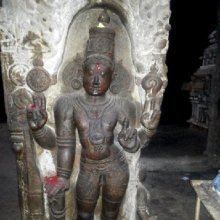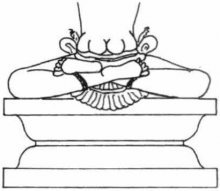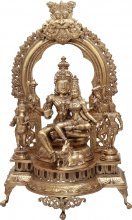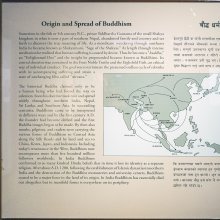Parivara, Parivāra, Pārivāra, Parīvāra: 26 definitions
Introduction:
Parivara means something in Buddhism, Pali, Hinduism, Sanskrit, the history of ancient India, Marathi, Jainism, Prakrit, Hindi. If you want to know the exact meaning, history, etymology or English translation of this term then check out the descriptions on this page. Add your comment or reference to a book if you want to contribute to this summary article.
Alternative spellings of this word include Parivar.
Images (photo gallery)
In Hinduism
Vaishnavism (Vaishava dharma)
Source: Pure Bhakti: Brhad BhagavatamrtamParivāra (परिवार) refers to:—Family; lineage. (cf. Glossary page from Śrī Bṛhad-bhāgavatāmṛta).

Vaishnava (वैष्णव, vaiṣṇava) or vaishnavism (vaiṣṇavism) represents a tradition of Hinduism worshipping Vishnu as the supreme Lord. Similar to the Shaktism and Shaivism traditions, Vaishnavism also developed as an individual movement, famous for its exposition of the dashavatara (‘ten avatars of Vishnu’).
Purana and Itihasa (epic history)
Source: archive.org: Shiva Purana - English TranslationParīvāra (परीवार) refers to a “family”, according to the Śivapurāṇa 2.3.11.—Accordingly, as Brahmā narrated: “After saying this, the lord of the mountains [i.e., Himācala/Himālaya] returned at once to his abode and enthusiastically narrated everything to his beloved wife. O Nārada, calling together all his attendants with the members of their families [i.e., parīvāra], the lord of the mountains said emphatically [...]”.

The Purana (पुराण, purāṇas) refers to Sanskrit literature preserving ancient India’s vast cultural history, including historical legends, religious ceremonies, various arts and sciences. The eighteen mahapuranas total over 400,000 shlokas (metrical couplets) and date to at least several centuries BCE.
Vastushastra (architecture)
Source: Brill: Śaivism and the Tantric Traditions (architecture)Parivāra (परिवार) or Parivārālaya refers to “subsidiary (shrines)”, according to the Devyāmata (chapter 105).—Accordingly, [trees for the surrounding gardens]—“[...] As before, the surrounding wall should be made straight, well erected and level. My dear, having established the subsidiary shrines (parivārālaya) beyond the wall, everything should be made thus, complete, and in due sequence. Beyond the residence, it is surrounded by a garden and has a surrounding wall. Everything to be done has been altogether declared. Thus ends the chapter on the residence”.

Vastushastra (वास्तुशास्त्र, vāstuśāstra) refers to the ancient Indian science (shastra) of architecture (vastu), dealing with topics such architecture, sculpture, town-building, fort building and various other constructions. Vastu also deals with the philosophy of the architectural relation with the cosmic universe.
Shaivism (Shaiva philosophy)
Source: eScholarship: The descent of scripture: a history of the KamikagamaParivāra (परिवार) refers to “attendant deities”, according to the Kāmikāgama: an ancient Śaiva Āgama scripture in 12,000 Sanskrit verses dating to at least the 5th century and represented as an encyclopedic account of ritual instructions (kriyāpāda).—In modern print editions, the Kāmika-āgama is structured in two major parts. The Pūrvabhāga consists of 75 chapters (paṭalas) [...] Chapter 71 details the characteristics of temple enclosures. Chapters 72 and 73 focus on the installation and worship of attendant deities (parivāra-sthāpana, parivāra-arcana).

Shaiva (शैव, śaiva) or Shaivism (śaivism) represents a tradition of Hinduism worshiping Shiva as the supreme being. Closely related to Shaktism, Shaiva literature includes a range of scriptures, including Tantras, while the root of this tradition may be traced back to the ancient Vedas.
In Buddhism
Mahayana (major branch of Buddhism)
Source: Wisdom Library: Maha Prajnaparamita SastraParivāra (परिवार) refers to the Bodhisattva’s “entourage”, according to the 2nd century Mahāprajñāpāramitāśāstra chapter L.—Accordingly, “the Bodhisattva wishes to acquire ‘a Bodhisattva entourage’ (parivāra). There are Buddhas who are surrounded only by Bodhisattvas; there are Buddhas who are surrounded only by śrāvakas; there are Buddhas who are surrounded by both bodhisattvas and śrāvakas. This is why the Prajñāpāramitāsūtra says here that, in order to acquire an entourage composed exclusively of Bodhisattvas, the Bodhisattva must practice the Prajñāpāramitā”.
There are three kinds of entourage (parivāra): superior, middling and inferior. The inferior one is made up of Śrāvakas alone; the middling one is a mixture [of Śrāvakas and Bodhisattvas]; the superior one consists only of Bodhisattvas.
Source: De Gruyter: A Buddhist Ritual Manual on AgricultureParivāra (परिवार) refers to the “retinue” (of a snake-king—nāgarāja), according to the 2nd-century Meghasūtra (“Cloud Sutra”) in those passages which contain ritual instructions.—Accordingly, “[...] For thrice seven days uninterruptedly, with cow-dung, in the eastern quarter the snake-king called Triple-crest, with his retinue (parivāra), must be painted; in the western, the snake king called Avabhāsanasikhin is to be painted, seven crested, with a retinue of serpents; in the north, the snake-king called Meghasaṃcodana, nine-crested, is to be depicted; a blue canopy and blue dress, blue banner and all the offering is to be made blue; but the sweet offering to the snakes, and the triple-sweet, must be offered,—an oblation of all; [...]”

Mahayana (महायान, mahāyāna) is a major branch of Buddhism focusing on the path of a Bodhisattva (spiritual aspirants/ enlightened beings). Extant literature is vast and primarely composed in the Sanskrit language. There are many sūtras of which some of the earliest are the various Prajñāpāramitā sūtras.
Tibetan Buddhism (Vajrayana or tantric Buddhism)
Source: OSU Press: Cakrasamvara SamadhiParivāra (परिवार) refers to “family” [i.e., sakala-parivārāṇāṃ], according to the Guru Mandala Worship (maṇḍalārcana) ritual often performed in combination with the Cakrasaṃvara Samādhi, which refers to the primary pūjā and sādhanā practice of Newah Mahāyāna-Vajrayāna Buddhists in Nepal.

Tibetan Buddhism includes schools such as Nyingma, Kadampa, Kagyu and Gelug. Their primary canon of literature is divided in two broad categories: The Kangyur, which consists of Buddha’s words, and the Tengyur, which includes commentaries from various sources. Esotericism and tantra techniques (vajrayāna) are collected indepently.
India history and geography
Source: Cologne Digital Sanskrit Dictionaries: Indian Epigraphical GlossaryParivāra.—(SII 3), a servant. Cf. horaka-parivāra (ML), explained as ‘the following of horakas.’ Note: parivāra is defined in the “Indian epigraphical glossary” as it can be found on ancient inscriptions commonly written in Sanskrit, Prakrit or Dravidian languages.

The history of India traces the identification of countries, villages, towns and other regions of India, as well as mythology, zoology, royal dynasties, rulers, tribes, local festivities and traditions and regional languages. Ancient India enjoyed religious freedom and encourages the path of Dharma, a concept common to Buddhism, Hinduism, and Jainism.
Languages of India and abroad
Pali-English dictionary
Source: BuddhaSasana: Concise Pali-English Dictionaryparivāra : (m.) retinue; suite; pomp; followers.
Source: Sutta: The Pali Text Society's Pali-English DictionaryParivāra, (fr. pari+vṛ) 1. surrounding, suite, retinue, followers, entourage, pomp J. I, 151; IV, 38; VI, 75; PvA. 21, 30 (°cāga-cetana, read pariccāga-cetana?); usually as adj.—° surrounded by, in company of Vin. I, 38 (dasasata°); A. II, 91 (deva° & asura°); J. I, 92 (mahā-bhikkhusaṅgha°); Pug. 52 (pheggu sāra°; with explanation PugA 229: rukkho sayaṃ-pheggu hoti, parivāra-rukkhā pan’assa sārā honti); Miln. 285 (dvisahassa-paritta-dīpa-p° ā, cattāro mahā dīpā); Vism. 37; DhA. III, 262 (pañcasatabhikkhu°); PvA. 53 (accharā-sahassa°), 74 (dvisahassadīpa°); sa° with a retinue (of ... ) J. I, 49 (cattāro dīpe); PvA. 20.—2. followers, accompaniment or possession as a sign of honour, and therefore meaning “respect, ” attendance, homage, fame (cp. paricāra) A. I, 38 °sampadā) Ps. I, 172 (pariggaha, p. , paripūra); DhA. II, 77; ThA. 241 (dhana+, riches and fame); VbhA. 466; PvA. 137 (sampatti=yaso); VvA. 122 (=yaso).—3. ingredient, accessories (pl.), requisite J. I, 266 (pañca-sugandhika°); Miln. 290 (sa° dāna); DA. I, 297 (=parikkhārā).—4. as N. it is the name of the last book of the Vinaya Piṭaka (“The Accessory”), the Appendix, a sort of résumé and index of the preceding books SnA 97 (sa-parivāraka Vinaya-piṭaka); VbhA. 432. (Page 435)

Pali is the language of the Tipiṭaka, which is the sacred canon of Theravāda Buddhism and contains much of the Buddha’s speech. Closeley related to Sanskrit, both languages are used interchangeably between religions.
Marathi-English dictionary
Source: DDSA: The Molesworth Marathi and English Dictionaryparivāra (परिवार).—m (S) Dependents, followers, retinue, train.
Source: DDSA: The Aryabhusan school dictionary, Marathi-Englishparivāra (परिवार).—m Dependents, retinue.
Marathi is an Indo-European language having over 70 million native speakers people in (predominantly) Maharashtra India. Marathi, like many other Indo-Aryan languages, evolved from early forms of Prakrit, which itself is a subset of Sanskrit, one of the most ancient languages of the world.
Sanskrit dictionary
Source: DDSA: The practical Sanskrit-English dictionaryParivāra (परिवार) or Parīvāra (परीवार).—
1) Train, retinue, attendants or followers collectively; (yānam) अध्यास्य कन्या परिवारशोभि (adhyāsya kanyā parivāraśobhi) R.6.1;12.16; ग्रहगणपरिवारो राजमार्गप्रदीपः (grahagaṇaparivāro rājamārgapradīpaḥ) Mṛcchakaṭika 1.57.
2) A cover, covering; व्याघ्रचर्मपरिवाराः (vyāghracarmaparivārāḥ) Mahābhārata (Bombay) 5.155.8;
3) A hedge round a village.
4) A sheath, scabbard; परिवारः परिजने खड्गकोशे परिच्छदे (parivāraḥ parijane khaḍgakośe paricchade) Medinī; परिवारात् पृथक्चक्रे खड्गश्चात्मा च केनचित् (parivārāt pṛthakcakre khaḍgaścātmā ca kenacit) Śiśupālavadha 19.49.
Derivable forms: parivāraḥ (परिवारः), parīvāraḥ (परीवारः).
--- OR ---
Parīvāra (परीवार).—&c. See परिताप (paritāpa) &c.
See also (synonyms): parītāpa, parīpāka, parīvāha, parīhāsa.
Source: Cologne Digital Sanskrit Dictionaries: Edgerton Buddhist Hybrid Sanskrit DictionaryParivāra (परिवार).—nt. (= Pali °ra, m., title of the Appendix to Vin., v.226.3, colophon), accessory (text), appendix, addendum: avalokitaṃ nāma sūtraṃ mahāvastusya pari- vāraṃ Mahāvastu ii.397.7, colophon to second version of the Avalokita sūtra.
Source: Cologne Digital Sanskrit Dictionaries: Shabda-Sagara Sanskrit-English DictionaryParivāra (परिवार).—m.
(-raḥ) 1. Dependent. 2. Train or retinue. 3. A scabbard, a sheath. E. pari round, vṛ to be, aff. ghañ.
--- OR ---
Parīvāra (परीवार).—m.
(-raḥ) 1. The sheath of a sword. 2. Dependents, family, retinue. E. pari around, vṛ to cover, aff. ghañ and the final of pari made long; also parivāra.
Source: Cologne Digital Sanskrit Dictionaries: Benfey Sanskrit-English DictionaryParivāra (परिवार).—i. e. pari-vṛ + a, m. 1. A cover, Mahābhārata 8, 1474. 2. Retinue, [Pañcatantra] 12, 20 (figur.); Daśak, in
Parivāra (परिवार).—[masculine] cover, covering, surroundings, train, retinue (adj. —° followed by).
--- OR ---
Parīvāra (परीवार).—[masculine] = parivāda, parivāra, & vāha.
Source: Cologne Digital Sanskrit Dictionaries: Monier-Williams Sanskrit-English Dictionary1) Parivāra (परिवार):—[=pari-vāra] a raṇa etc. See pari-vri.
2) [=pari-vāra] [from pari-vṛ] b m. (also parī-v) a cover, covering, [Mahābhārata] (also -ka, [Kātyāyana-śrauta-sūtra [Scholiast or Commentator]])
3) [v.s. ...] surroundings, train, suite, dependants, followers (ifc. [f(ā). ] surrounded by), [Mahābhārata; Kāvya literature] etc.
4) [v.s. ...] a sheath, scabbard, [Śiśupāla-vadha]
5) [v.s. ...] a hedge round a village, [Demetrius Galanos’s Lexiko: sanskritikes, anglikes, hellenikes] (cf. parī-v)
6) Parīvāra (परीवार):—[=parī-vāra] [from parī] m. train, retinue, [Mahābhārata; Kāvya literature] etc.
7) [v.s. ...] a sheath, scabbard, [cf. Lexicographers, esp. such as amarasiṃha, halāyudha, hemacandra, etc.] (cf. pari-v under pari- √1. vṛ).
Source: Cologne Digital Sanskrit Dictionaries: Yates Sanskrit-English Dictionary1) Parivāra (परिवार):—[pari-vāra] (raḥ) 1. m. A dependant; a retinue; a sheath or scabbard.
2) Parīvāra (परीवार):—[parī-vāra] (raḥ) 1. m. The sheath of a sword; family; retinue.
Source: DDSA: Paia-sadda-mahannavo; a comprehensive Prakrit Hindi dictionary (S)Parivāra (परिवार) in the Sanskrit language is related to the Prakrit word: Parivāra.
[Sanskrit to German]
Sanskrit, also spelled संस्कृतम् (saṃskṛtam), is an ancient language of India commonly seen as the grandmother of the Indo-European language family (even English!). Closely allied with Prakrit and Pali, Sanskrit is more exhaustive in both grammar and terms and has the most extensive collection of literature in the world, greatly surpassing its sister-languages Greek and Latin.
Hindi dictionary
Source: DDSA: A practical Hindi-English dictionaryParivāra (परिवार) [Also spelled parivar]:—(nm) a family; household; —[calānā] to run a family/household; —[ṭūṭanā] a family to break-up.
...
Prakrit-English dictionary
Source: DDSA: Paia-sadda-mahannavo; a comprehensive Prakrit Hindi dictionary1) Parivāra (परिवार) in the Prakrit language is related to the Sanskrit word: Parivāra.
2) Parivāra (परिवार) also relates to the Sanskrit word: Parivāra.
Prakrit is an ancient language closely associated with both Pali and Sanskrit. Jain literature is often composed in this language or sub-dialects, such as the Agamas and their commentaries which are written in Ardhamagadhi and Maharashtri Prakrit. The earliest extant texts can be dated to as early as the 4th century BCE although core portions might be older.
Kannada-English dictionary
Source: Alar: Kannada-English corpusParivāra (ಪರಿವಾರ):—
1) [noun] a large number of persons following, sorrounding, etc. a person; a retinue.
2) [noun] that which surrounds or encircles another.
3) [noun] a group of people; a crowd.
4) [noun] a social unit consisting of parents and the children they rear; a family.
Kannada is a Dravidian language (as opposed to the Indo-European language family) mainly spoken in the southwestern region of India.
Nepali dictionary
Source: unoes: Nepali-English DictionaryParivāra (परिवार):—n. 1. family; dependents; relatives; 2. members sharing the same roof a kitchen; 3. attendants; retinue;
Nepali is the primary language of the Nepalese people counting almost 20 million native speakers. The country of Nepal is situated in the Himalaya mountain range to the north of India.
See also (Relevant definitions)
Starts with (+5): Parivara-niyojana, Parivaradevata, Parivaradevate, Parivaradevi, Parivaraka, Parivarakkontam, Parivaralaya, Parivaralayam, Parivaramgane, Parivaramurti, Parivaran, Parivarana, Parivarapatha, Parivararcana, Parivarasadharana, Parivarasadharanasthapana, Parivarasameta, Parivarasamyuta, Parivarashobhin, Parivarasthapana.
Ends with (+5): Abhinnaparivara, Agneya-parivara, Alpaparivara, Asuraparivara, Bahujanaparivara, Devaparivara, Ekala-parivara, Hudara-parivara, Jahana-parivara, Kimparivara, Mahaparivara, Nagaparivara, Nagara-parivara, Ragaparivara, Rajaparivara, Samyukta-kutumba-va-parivara, Samyukta-parivara, Saparivara, Shataparivara, Suciparivara.
Full-text (+68): Parivarapatha, Parivarata, Parivaravant, Parivaravat, Parivarashobhin, Parivaralaya, Parivaha, Akapparivaram, Parivarikri, Parivaradevata, Parivaraka, Alpaparivara, Apatti, Shataparivara, Kimparivara, Vastu-parivara, Nagara-parivara, Sanyukt-parivaar, Hudar-parivaar, Saparivara.
Relevant text
Search found 42 books and stories containing Parivara, Parivāra, Pārivāra, Parīvāra, Pari-vara, Pari-vāra, Parī-vāra; (plurals include: Parivaras, Parivāras, Pārivāras, Parīvāras, varas, vāras). You can also click to the full overview containing English textual excerpts. Below are direct links for the most relevant articles:
Brihad Bhagavatamrita (commentary) (by Śrī Śrīmad Bhaktivedānta Nārāyana Gosvāmī Mahārāja)
Verse 2.3.54 < [Chapter 3 - Bhajana (loving service)]
Verse 2.4.34 < [Chapter 4 - Vaikuṇṭha (the spiritual world)]
Verse 2.3.51 < [Chapter 3 - Bhajana (loving service)]
Vinaya Pitaka (4): Parivara (by I. B. Horner)
The Five Divisions (Fifth Division ) < [21. The Five Divisions]
Rig Veda (translation and commentary) (by H. H. Wilson)
Rig Veda 9.86.25 < [Sukta 86]
Early Chola Temples (by S. R. Balasubrahmanyam)
Ashta Parivara Devatas < [Chapter XIII - Prasada: Component Parts]
Temples in Erumbur (Urumur) < [Chapter II - Temples of Parantaka I’s Time]
Temples in Erumbur (28th year) < [Chapter X - Historical Survey]
Guide to Tipitaka (by U Ko Lay)
Sahitya-kaumudi by Baladeva Vidyabhushana (by Gaurapada Dāsa)
Text 7.125 < [Chapter 7 - Literary Faults]
Text 10.90 < [Chapter 10 - Ornaments of Meaning]
Related products




